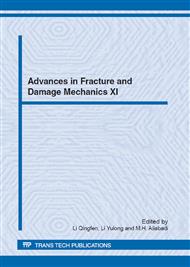p.497
p.501
p.505
p.509
p.513
p.517
p.521
p.525
p.529
Crack Modelling Using the Material Point Method and a Strong Discontinuity Approach
Abstract:
Modern numerical techniques utilised to model crack propagation tend to be optimized for tracking the evolution of a single crack. Real fracture processes are however complex, involving the initiation and propagation of opening (activated) cracks, while other may close (deactivate) and undergo frictional dissipations. Accounting for the correct loss of energy (through debonding and friction) is essential to achieving a realistic description of the fracture process. One common strategy has been to make small adaptations to traditional techniques to tackle multiple cracking, in effect relying on extensive complicated computational algorithms. A typical example is the use of cohesive models in combination with the eXtended finite Element method where cracks, sometimes intersecting, need to be defined explicitly. In this study the Material Point Method is used for the analysis of fracture propagation. Crack states, as internal variables, are stored within the material points and mapped as strong discontinuities to the elements during the Lagrangian phase of the solution. Consequently, material points carrying cracks of different sizes and orientations are allowed to cohabit within the same element, yielding a natural description of the fracture/fragmentation process. The three-point bending test is used to demonstrate the features of the new approach.
Info:
Periodical:
Pages:
513-516
Citation:
Online since:
November 2012
Authors:
Keywords:
Price:
Сopyright:
© 2013 Trans Tech Publications Ltd. All Rights Reserved
Share:
Citation:


